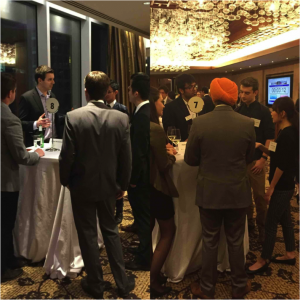You arrive at your networking/info session event in your newly bought business outfit. The feeling of importance may or may not strike you. You look around, spotting the important things:
Food? Check.
That little miracle to inspire that fierce inner confidence called alcohol? Check.
If not, then it is just you and your nametag.
You find a seat. The presentation starts. One of two things may happen: you may zone out trying to think of questions you can ask to “stand out” during the question period, or try to think of conversation topics that would last more than a few seconds – attempting to think of methods you could use to seem calm and interesting. You sit through the presentation. A company seems kind of interesting. Now you realize the presentation is coming to an end – the dreaded networking is about to happen…
For those “social butterflies”, meeting new people can be exhilarating and rewarding. However, for others, the mere thought of meeting new people could elicit significant anxiety. Now, what may be the underlying cause of this discomfort, and how can we overcome such uneasiness to enable a more pleasant and an impactful experience?
Understanding the root causes of anxiety-related problems is an essential step in overcoming the challenge of the networking fear!
 It has to do with the mismatch between modern and ancestral environments. The characteristics humans possess today are a result of adaptations to a multitude of social and physical challenges our ancestors faced, which may not be well-adapted for life in our modern society. Unfortunately for us, social fear is the result of this mismatch.
It has to do with the mismatch between modern and ancestral environments. The characteristics humans possess today are a result of adaptations to a multitude of social and physical challenges our ancestors faced, which may not be well-adapted for life in our modern society. Unfortunately for us, social fear is the result of this mismatch.
Psychology says our brains have evolved to compete for “attractiveness” – to make good impressions on others because these are related
to obtaining important social resources and investments from others. Being ostracized carries many negative consequences. So, your brain activates “submissive defensives”, which trigger characteristics such as self-consciousness, eye-gaze avoidance, inferiority, or submission, leading to interference with our confident performance.
But, there is good news! Our brains can be tricked into maintaining our awesomeness when we need it most.
- Reappraise Those Body Sensations
What is the difference between a “social butterfly” and a person with social anxiety? Conscious or unconscious appraisal of the bodily sensations. More or less we experience the same amount of stimulation in social situations. New situations trigger the adrenaline rush that increases our heart rate and oxygen delivery to the brain allowing us to be quicker on our feet. The trick is to understand that the sensations of “nervousness” are actually positive signs from our body to use to our advantage rather than an evil mechanism that inhibits our thinking. This is in line with the well-known self-fulfilling prophecy.
- Increase Certainty
The uncertainty of meeting new people induces anxiety. Therefore, one way to trick your brain and reduce this anxiety is to create a sense of certainty around the situation. First, there is certainty in knowing that not everyone is going to like you, no matter what “show” you put on. So be yourself – it is much easier to be in your own skin than in someone else’s. Second, create more certainty around the topic you will talk about by preparing 2 – 3 questions (the trick here is not to be lazy about it!). Third, reminding yourself that nothing horrible will happen if you say something rather “awkward” and you can be certain no one will even notice because no one is thinking about you. Everyone is too busy thinking about themselves.
- “Meeting Friends” or “Game”
Language is a powerful tool. Language and words we use trigger emotions and our emotions propel us into particular actions. Therefore, calling “networking” something else may alleviate the many stresses you have around the notion of meeting new people. Try calling it “meeting friends”. It’s just talking to nice people with whom you get on well and talking about things that you’re interested in. Or call it a “game”, and actually create small games for yourself prior to attending an event. For example, “today I will talk to 4 people, and find one interesting fact about them”. It doesn’t have to only be the company representatives. Networking opportunities are everywhere.
Of course, the list is not exhaustive in terms of what you can do better your experience. Just remember: people are people, and even CEO’s of big companies are nervous about new, social situations, yet, it does get easier with practice.
And really… at the end of the day, ask yourself, what’s the worst that can happen? MM Networking Exchange 2016
MM Networking Exchange 2016
– Yanna Baiman
 Follow
Follow